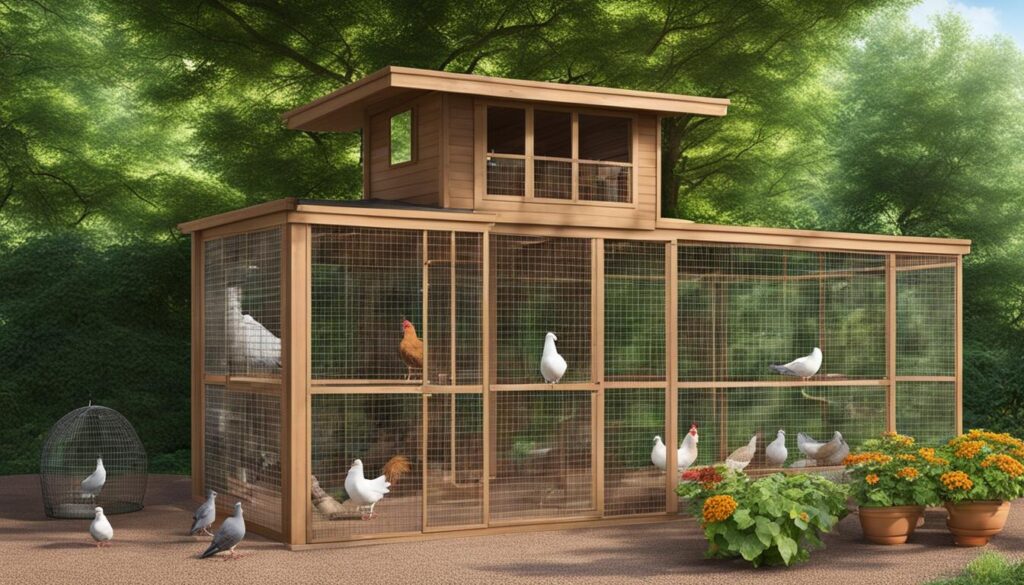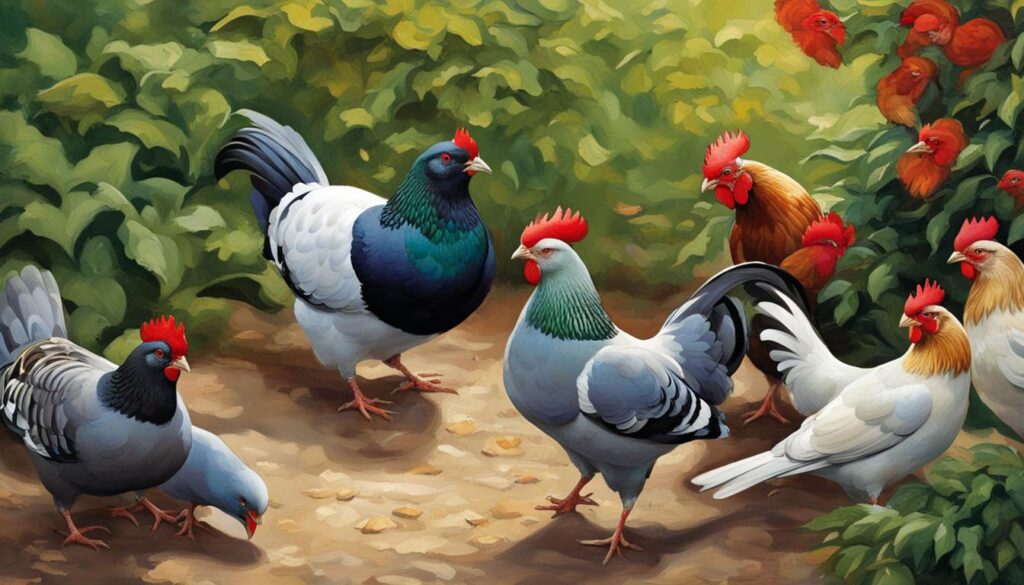As a hobby farmer with a passion for nurturing a thriving backyard setup, I’ve always been fascinated by the idea of mixed avian habitats. The concept of harmonious cohabitation of pigeons and chickens in one space ignites a curiosity within me and many fellow avian enthusiasts. It begs the question: Can these different species truly live together in harmony? This burning question draws me to explore not only the feasibility but also the ways to foster a peaceful community of these common backyard birds.
It’s not simply about throwing diverse birds together and hoping for the best – no, it’s about understanding each species’ needs and behaviors and crafting an environment conducive to their coexistence. Join me on this exploratory journey, as I dive into the heart of creating a serene and symbiotic environment for both pigeons and chickens to flourish side by side.
Key Takeaways
- Exploring the possibility of pigeons and chickens cohabiting successfully.
- Understanding the special requirements for creating mixed avian habitats.
- Assessing spatial and behavioral considerations for a harmonious backyard setup.
- Addressing health management for mixed species to prevent diseases.
- Importance of personalized care strategies tailored to each species’ unique needs.
- Proactive planning for a peaceful coexistence between pigeons and chickens.
Understanding the Dynamics of Mixed Avian Habitats
As I delve deeper into the world of mixed avian habitats, I find myself captivated by the cohabitation dynamics that define the relationships between different bird species. The compatibility of avian species is not a matter to be taken lightly if one hopes to master mixed flock management. Let me share with you the key findings from observing and interacting with these feathered friends.
Observing pigeons and chickens, it’s evident that each bird has unique social structures and environmental needs. For hobbyists like myself, deciphering these nuances can mean the difference between chaos and tranquility in our backyard habitats.
- Behavioral Observations: Chickens often establish a pecking order, which can lead to bullying when new birds are introduced. Pigeons, with their peaceful nature, can sometimes be on the receiving end of such behaviors.
- Space and Environment: Both species need their own space. Chickens require room to forage and roost, while pigeons need ledges or rafters for nesting and resting.
- Disease Management: Diseases can spread quickly in mixed flocks. Keeping each species healthy involves monitoring for signs of illness and maintaining clean living spaces.
Understanding each bird’s need for space, social interaction, and overall health considerations is key in creating a habitat in which both pigeons and chickens can not only survive but thrive.
In my journey, I’ve come to appreciate the importance of establishing a set of ground rules when managing a mixed flock. The following table provides a comparative overview of the specific needs of pigeons and chickens:
| Factor | Pigeons | Chickens |
|---|---|---|
| Nesting Preferences | High, secluded spots | Nesting boxes close to the ground |
| Social Structure | Pair-bonded, less pecking order | Clear pecking order, more hierarchy |
| Food Habits | Grain, vegetables, will scavenge less | Omnivorous, proactive foragers |
| Space Requirements | Less roaming area, needs ledges | More ground space for foraging and roaming |
| Health Considerations | Prone to respiratory issues | Can attract mites, susceptible to parasites |
In conclusion, by respecting the inherent differences and natural behaviors of both pigeons and chickens, we can create a stable and stress-free atmosphere for all. The path to harmonious cohabitation in mixed avian habitats lies in the delicate balance of meeting each species’ environmental needs, understanding their social structures, and mitigating health risks through attentive flock management.
Essential Tips for Housing Pigeons and Chickens
As a hobby farmer, I’ve learned that the success of avian housing hinges on attention to detail and understanding the unique requirements of each bird species. It’s not simply about providing shelter; it’s about crafting a habitat that fosters peaceful coexistence. Below are some of the foremost strategies I’ve used to ensure my feathered friends live in harmony.

Space Considerations for Peaceful Coexistence
Enabling pigeons and chickens to coexist peacefully begins with the thoughtful allocation of space. It’s crucial to provide ample room for each bird to roost, forage, and retreat. Diverse avian species can live side by side when given enough territory to establish their own pecking order without overcrowding, which often leads to stress and aggression.
Dietary Requirements and Feeding Stations
While pigeons and chickens share some nutritional needs, it’s vital to cater to their individual dietary preferences. Pigeons, requiring a diet rich in grains and seeds, benefit from elevated feeding platforms that chickens cannot reach, while chickens need convenient access to their own feed, rich in proteins and calcium, ensuring they meet their unique nutritional demands.
| Species | Primary Nutritional Needs | Feeding Station Design |
|---|---|---|
| Pigeons | Grains, Seeds | Elevated, Perch-Accessible |
| Chickens | Protein, Calcium | Ground Level, Spacious |
Health and Hygiene Practices to Prevent Disease
Preventing disease in a mixed-species aviary is paramount. Proactive health and hygiene practices are the foundation of disease prevention. This entails regular cleaning of living quarters, provision of clean water, and monitoring for signs of illness. Avian diseases can spread quickly; by maintaining rigorous cleanliness, the risk of contagion is greatly diminished, securing the wellbeing of the entire flock.
Can Pigeons and Chickens Live Together in Harmony?
As I delve into the world of backyard bird care, a question that often arises is about the feasibility of pigeons and chickens living side by side in a state of harmonious avian cohabitation. The answer isn’t simple, as it rests on understanding their distinct needs and behaviors. In my journey, I’ve had first-hand experience and have gathered insight from other hobby farmers, which has helped me draw conclusions about the success of these interspecies relationships.
Analyzing Behavioral Patterns
One of the keys to fostering a peaceful environment is constant behavioral observations of your feathered friends. Pigeons, known for their gentle nature, can often coexist with chickens, but there needs to be monitoring of the flock dynamics. Chickens can be more territorial and may require more personal space than pigeons. Ensuring that there are plenty of perch spaces and that feeders are not too close together can help mitigate any potential disputes over resources.
Introducing Birds to One Another: Dos and Don’ts
When it comes to successful introduction strategies, here are a few tips I’ve learned:
- Do: Start by allowing the birds to see each other without physical contact, using a fence or separate enclosures. This can prevent immediate territorial disputes.
- Don’t: Rush the process. Birds need time to get accustomed to the presence of other species.
- Do: Provide individual feed and water stations for pigeons and chickens initially to avoid competition.
- Don’t: Ignore signs of distress or aggression. If you notice any pecking or chasing, separate the birds and slow down the introduction process.

Common Challenges and Practical Solutions
During the process of mingling these species, some challenges are to be expected. However, for every problem, there is a solution rooted in patience and adaptability:
| Challenge | Practical Solution |
|---|---|
| Pigeons outnumbering chickens | Limit the number of pigeons or increase coop space. |
| Aggressive roosters | Implement behavioral training or rehome to prevent injury to pigeons. |
| Nesting site competition | Provide ample and separate nesting areas for each species. |
| Differing dietary needs | Offer species-specific diets in clearly marked feeding areas. |
By considering these factors, I’ve seen many hobby farmers achieve a serene and thriving mixed flock. Remember, observing and adjusting practices based on your birds’ behaviors is the essence of creating a harmonious avian community in your backyard.
Designing the Ideal Coop for Diverse Bird Species
In my journey to establish a harmonious backyard haven for pigeons and chickens alike, I’ve discovered that the secret lies in an optimal coop design—one that not only provides shelter but also caters to the behavioral intricacies and physical needs of these distinctive avian friends. To accommodate diverse avian species, my hobby farm infrastructure requires a coop that is not just a building but a carefully thought-out habitat. Here, I’ll share the essence of creating a versatile space that allows pigeons to roost and chickens to nest, each in their peaceful nooks.
For me, successful coop construction means observing and integrating the natural habits of my feathery companions. By maximizing space utilization, I ensure that both pigeons and chickens have ample room to engage in their unique activities without encroaching on each other’s territory. The implementation of separate feeding and roosting zones is crucial, and I’ve found that thoughtful placement of these areas promotes a stress-free environment. High perches for pigeons and secluded nesting boxes for chickens illustrate my commitment to satisfying the intrinsic tendencies of both species.
Finally, I emphasize the importance of safety and ease of maintenance in this diverse ecosystem. The design features of my coop include predator-proofing, proper ventilation, and materials that stand up to the wear of time and weather. It’s about creating a space where I can seamlessly care for my birds while ensuring they thrive. The accomplishment of crafting such a space has not only enriched the lives of my avian companions but has brought immense joy and satisfaction to my role as a hobby farmer. In the end, it’s these multi-species melodies that echo the most harmoniously across my quaint piece of pastoral paradise.
